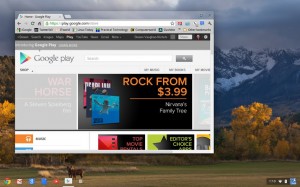Google's new Chrome OS: Back to the future

I have little love for the new generation of desktop interfaces, such as Windows 8 Metro. They use a smartphone/tablet like metaphor in which each application takes up the entire screen. So, why did I buy all these 20-inch and larger displays? Google, in the latest developer release of its Linux and cloud-based Chrome OS, has reversed this trend. This developer Chrome OS update adds a taskbar and support for multiple windows to its light-weight, desktop operating system.
Say hello to Google’s new, old Chrome OS (gallery)
This new interface, Aura, is both a new desktop window manager and shell environment. Aura is an optional replacement for last year's Chrome OS single Web browser interface. With it you can have multiple, small browser windows, each with its own set of tabs, against a desktop screen background. These windows can be overlapped like the Windows on older desktops such as GNOME 2.x, Windows 7 or Mac OS X.
You also get, like OS X's dock, a status bar on the bottom of the screen with icons for each of the open windows and system status displays for as the clock and battery. When you maximize a window to full screen, the task bar vanishes. You can always bring it back though by moving your pointer down to the screen's bottom.
You can also tear off browser tabs and drag their windows to new positions or merge tab with another window's tab strip. Each window also gets a rectangle in the upper right that you can toggle to switch between its maximized and smaller displays. You can also resize windows by dragging any edge. If you click on an icon in the dock you'll see icons for all your installed apps and bookmarks. You can also find these on Chrome OS' new-tab page.
If Aura sounds familiar, it should. While so many of the new operating systems want to force you to have only one application at a time in front of your face, Chrome OS is returning to the older way of enabling you to have multiple windows up at once. This is a win as far as I'm concerned.
This latest edition of Chrome OS, 19.0.1048.17, includes numerous security fixes. In addition, it now includes better support for multiple monitors and it provides native support for the tar, gz, and bzip2 compressed file archive formats.
This is a developer's release, so it's for power-users only. While technically it's only available for users who already own a Acer AC700 or Samsung Series 5 Chromebook--the first Chromebooks, the CR-48s, are not supported in this release-you can also run Chrome OS from a USB stick or in a VirtualBox virtual machine.
I've always like Chrome OS. To me, it's a nice mix of Linux and cloud computing. Thanks to Hexxen, it's easy for a power-user to check it out. So, even if you don't have a Chromebook, give it a try. I think you might just like it.
Related Stories:
New Chromebooks to get a much-needed Ivy Bridge speed boost?
Google wants you to buy a Chromebook: Should you? (Review)
How to install Google's Chrome OS
Five Reasons why Google's Linux Chromebook could be a Windows killer
